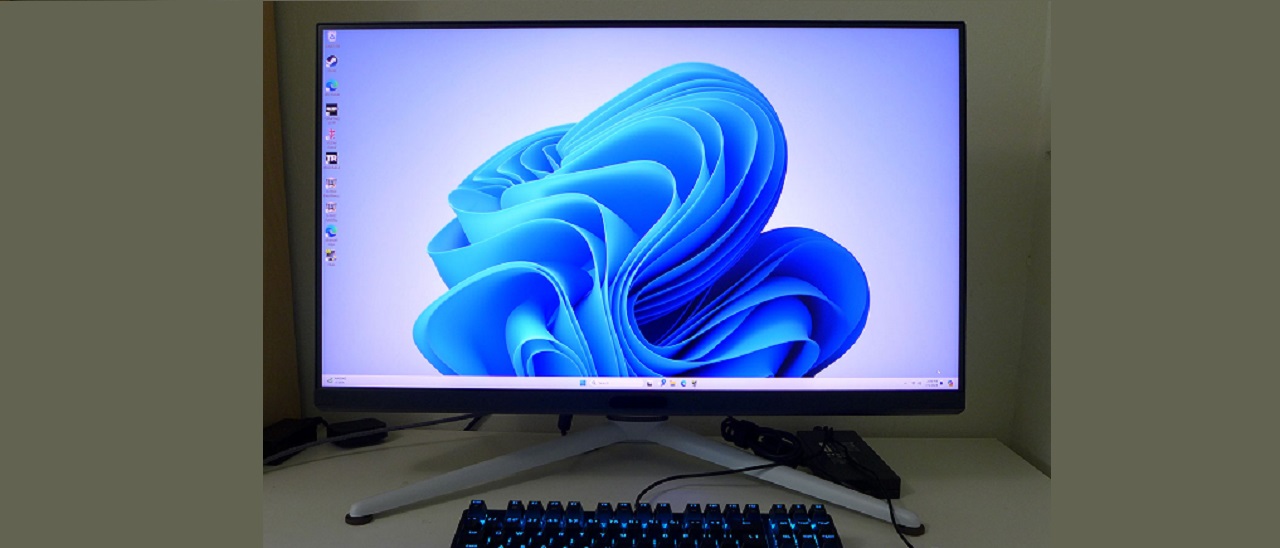Tom's Hardware Verdict
Despite a few quirks, the BenQ MOBIUZ EX321UX delivers an excellent image and smooth game performance. It runs with the best in the 4K 144 Hz category.
Pros
- +
Bright and colorful image
- +
Excellent HDR color and contrast
- +
Two accurate color modes
- +
Top-shelf video processing with low input lag
- +
Excellent audio quality through the headphone output
- +
Unique styling with solid build quality
Cons
- -
No local dimming or calibration in color accurate modes
- -
No backlight strobe for blur reduction at low frame rates
- -
No LED lighting or internal speakers
Why you can trust Tom's Hardware
With all the latest monitor buzz centered around OLED panels, it’s easy to forget that some truly excellent LCD panels can deliver stunning images with color and clarity while offering excellent gaming performance and peak brightness that OLED can’t match. I’m talking about 1,000 nits or more, which is a difficult goal for an OLED but no problem for Mini LED.
BenQ’s MOBIUZ line of gaming monitors includes value prospects and premium displays when it comes to the best 4K gaming monitors. The EX321UX is firmly in the latter category at around $1,200. For that sum, you get a 32-inch IPS Mini LED panel with 4K 3840x2160 resolution, 1,152 dimming zones, wide gamut color, HDR1000, 144 Hz, and Adaptive Sync. It also comes with the latest video inputs, including DisplayPort 2.1 and HDMI 2.1. It’s refreshingly styled and even includes a handy remote control. Let’s take a look.
BenQ MOBIUZ EX321UX Specs
| Panel Type / Backlight | IPS / QD-LED |
| Row 1 - Cell 0 | Full array, local dimming |
| Row 2 - Cell 0 | 1,152 zones |
| Screen Size / Aspect Ratio | 32 inches / 16:9 |
| Max Resolution and Refresh Rate | 3,840x2,160 @ 144 Hz |
| Row 5 - Cell 0 | FreeSync: 48-144 Hz |
| Row 6 - Cell 0 | G-Sync Compatible |
| Native Color Depth and Gamut | 10-bit / DCI-P3+ |
| Row 8 - Cell 0 | HDR10, Display HDR 1000 |
| Response Time (GTG) | 1ms |
| Brightness (mfr) | 750 nits SDR |
| Row 11 - Cell 0 | 1,000 nits HDR |
| Contrast (mfr) | 1,000:1 |
| Speakers | None |
| Video Inputs | 1x DisplayPort 2.1 |
| Row 15 - Cell 0 | 3x HDMI 2.1 (1 w/eARC) |
| Row 16 - Cell 0 | 1x USB-C |
| Audio | 3.5mm headphone output |
| USB 3.2 | 1x up, 4x down |
| Power Consumption | 36w, brightness @ 200 nits |
| Panel Dimensions WxHxD w/base | 28.1 x 19-23 x 12 inches (714 x 483-584 x 240mm) |
| Panel Thickness | 3.9 inches (99mm) |
| Bezel Width | Top/sides: 0.3 inch (8mm) |
| Row 23 - Cell 0 | Bottom: 1 inch (25mm) |
| Weight | 21.4 pounds (9.7kg) |
| Warranty | 3 years |
While OLEDs have, in my opinion, the best image quality, thanks to their broad contrast, they aren’t super bright. If you want maximum light output, Mini LED is the tech for you. Most will top 1,000 nits in HDR mode and some, like Samsung’s Neo G8, have cracked 2,000 nits. The EX321UX isn’t quite that bright. It’s certified VESA DisplayHDR 1000 and my sample hit 1,300 nits when measuring a 25% window. Local dimming comes into play with 1,152 zones.
BenQ delivers a lot of color volume with a Quantum Dot film covering 99% of DCI-P3. My sample topped 104%, so plenty of saturation is available for the latest HDR content. Two accurate picture modes promise spot-on DCI-P3 and sRGB gamuts for critical applications. HDR10 is supported with five additional modes that each offer a different look for your favorite games.
The max refresh rate is 144 Hz, which in today’s landscape is about as slow as you’ll want for a gaming monitor. But since the EX321UX is 4K, you’ll need a lot of video card power to hit that frame rate. BenQ has one of the best overdrives I’ve seen, and it’s included here. There’s no backlight strobe, but my tests showed minimal blur and no ghosting artifacts. FreeSync and G-Sync work flawlessly, but the EX321UX has not been certified by Nvidia.
Usually, I comment that monitors with a white finish are unique. But lately, I’ve seen a few, so I’ll update my opinion – it’s nice to see some new designs appearing on the market. Enterprise screens will likely always be black and plain, but gaming monitors are a blank canvas. The EX321UX is black in the front only. Every other surface is a bright white with a few copper accents on the base. It fits in with the latest gaming consoles. Its inputs, DisplayPort 2.1 and HDMI 2.1, also fit into the latest systems. One USB-C port also supports video input, and other USBs support peripherals and charging.
The only things left out here are internal speakers and LED lighting. But the headphone jack supports audio modes, and you get a handheld remote. The OSD is very flexible and includes a multitude of picture presets and settings memories so you can quickly pivot between work and play.
Get Tom's Hardware's best news and in-depth reviews, straight to your inbox.
At $1,200 to start, the EX321UX is definitely a major purchase. But it offers excellent image quality, solid gaming and BenQ’s typical high-end build quality.
Assembly and Accessories
The EX321UX comes in a clamshell box packed in molded pulp rather than crumbly foam. It is fully recyclable—kudos to BenQ. The three main bits assemble without tools. The panel has a 100mm VESA mount in the back with fasteners included. An enormous brick serves as the power supply. Cables include HDMI, USB-C/C, and USB-C/A, but oddly, no DisplayPort. You also get a small handheld remote, which, oddly, does not include the necessary CR2032 button battery.
Product 360

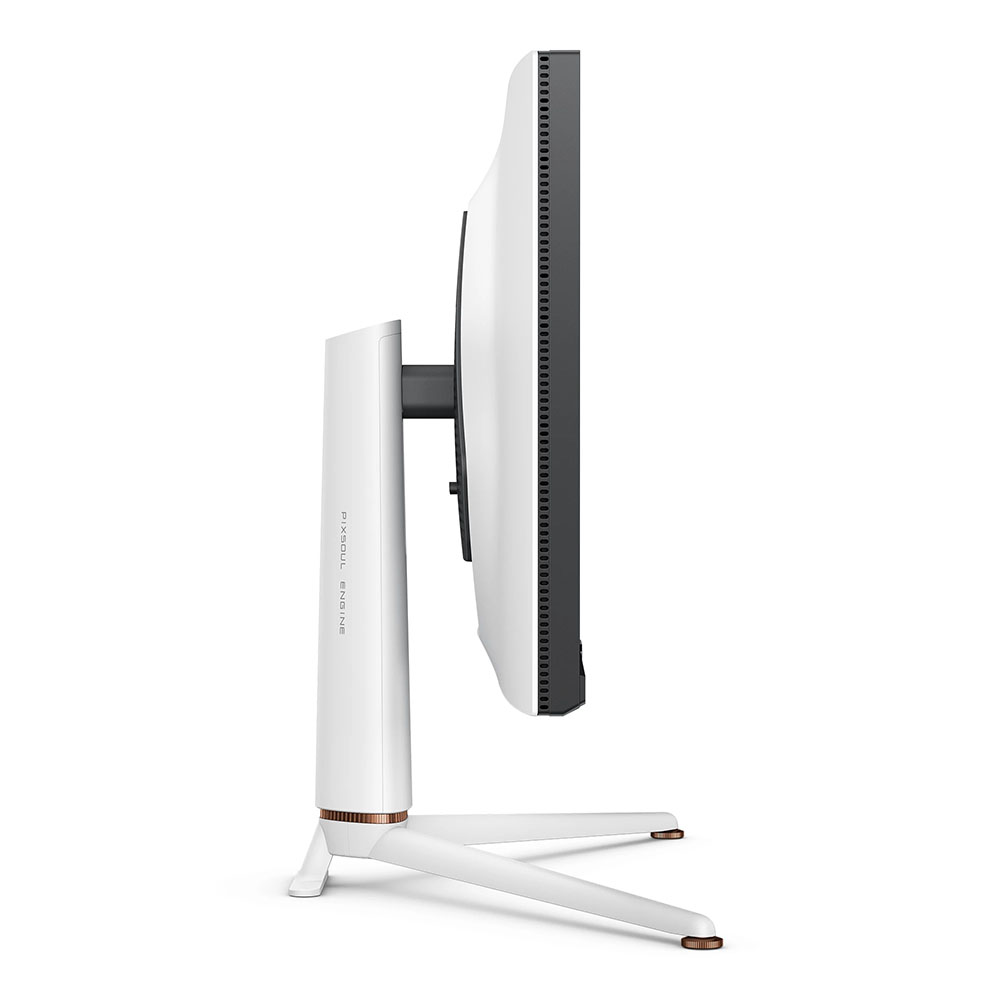



The EX321UX is all-screen in the front with a very thin flush bezel. It’s narrower than what’s found on most 32-inch monitors at just eight millimeters wide. The bottom trim is a full inch and has ambient light and IR sensors for the Brightness Intelligence+ feature and for the remote control. Underneath is a tiny joystick for OSD control along with a backlit power key and a single control key for input selection.
The inputs face rearwards and are very easy to access. You get three HDMI 2.1 ports, one of which supports eARC (Audio Return Channel). This makes soundbar and speaker integration very easy. The single DisplayPort is version 2.1. If you are running a GeForce RTX 4090 and are concerned about compatibility (it only supports DP 1.4), don’t worry. The EX321UX switches versions automatically. I had no issues running HDR and G-Sync with 10-bit color at 144 Hz. You can also run video through a USB-C port that mimics DisplayPort functions. A second USB-C provides upstream support for three USB-A downstream jacks, version 3.2. Underneath the panel center is the headphone jack and one each of USB-A and USB-C. The latter supports charging up to 7.5 watts.
There are no internal speakers, but the headphone jack has three different sound modes that provide a decent approximation of surround audio. You can easily control the volume and switch modes with the remote, providing quick access to picture modes, settings memories, brightness, and the heads-up display with signal and frame rate info.
The stand is all white with small copper accents at the front feet and the swivel point. Speaking of ergonomics, there is a four-inch height adjustment plus 15 degrees of swivel and 5/15 degrees of tilt. There is no portrait mode. The stand is fairly solid, but there is some play at the panel’s attachment point.
OSD Features
The EX321UX’s OSD is loaded with options and can be a bit confusing with its large selection of picture and settings memories. It has its own dedicated button on the remote, which is the easiest way to access it.

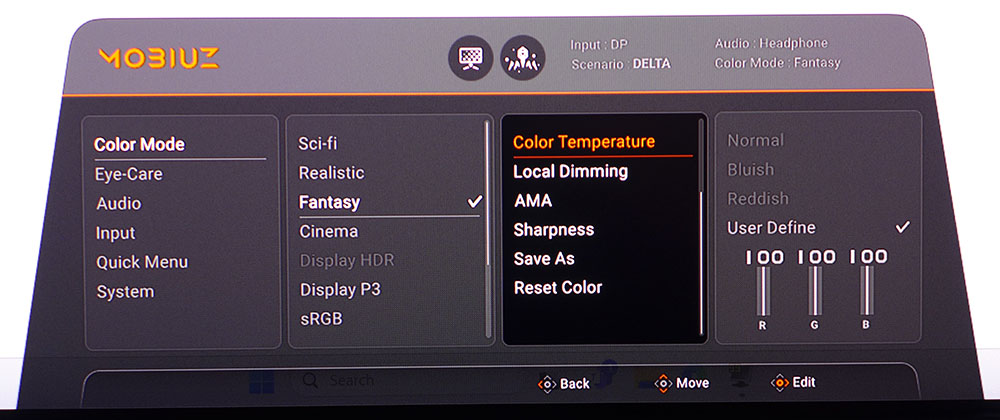
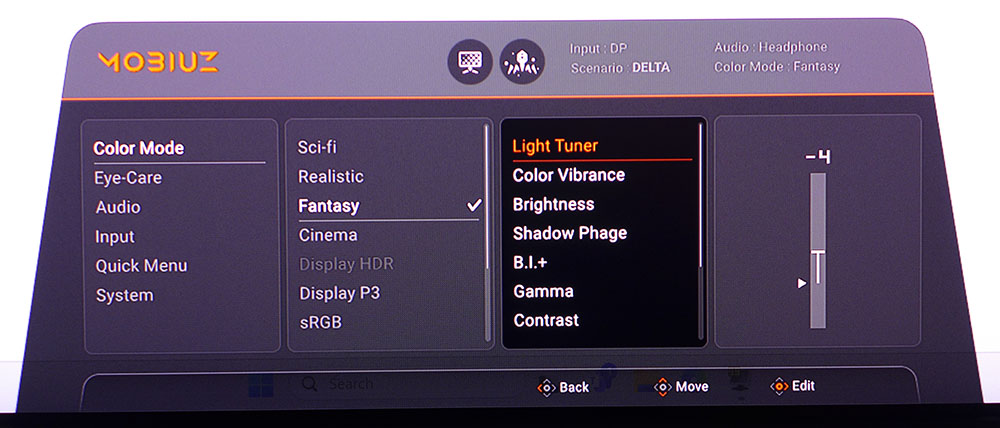
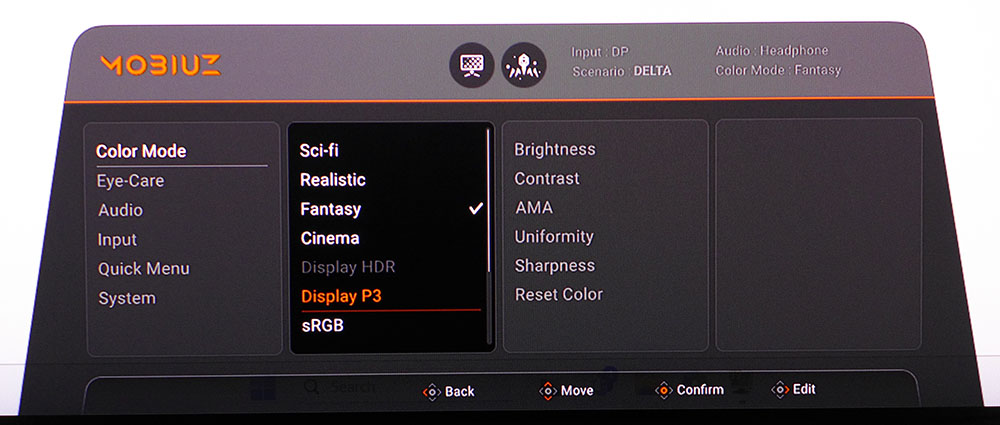
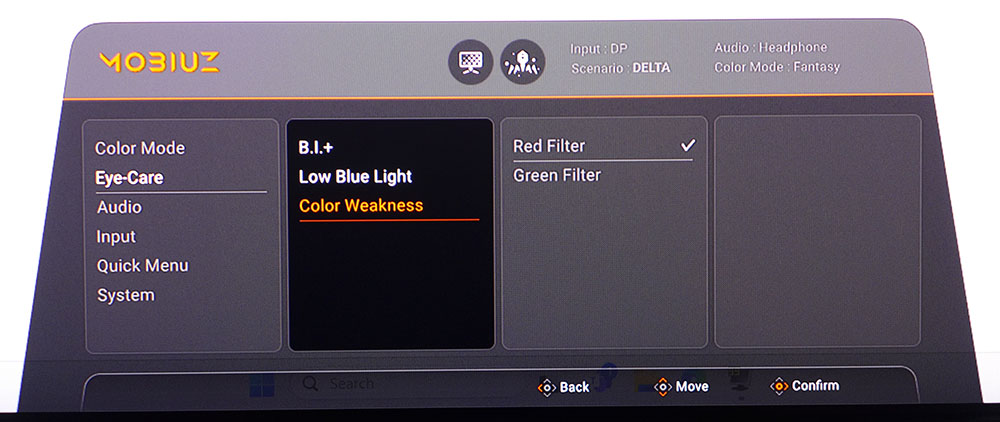





The first photo shows the heads-up display that appears whenever you open the OSD or press the remote button with the symbol of a gaming controller on it. It shows FreeSync/G-Sync status, HDR, input resolution and the current refresh rate. It will vary when you’re playing games and you can leave it on all the time if you like.
The main menu rises from the bottom of the screen and includes six sub-menus. Each of the 10 SDR picture modes has its own settings that appear to the right. The default one is Fantasy and while it looks decent, its gamma is quite far from standard. I’ll talk more about that on page four. The accurate modes are Display P3 and sRGB, and you can adjust their brightness, but unfortunately, they don’t let you use the Local Dimming feature. It’s there in HDR mode just fine but it’s a bummer that the EX321UX’s two color-accurate modes lock out the local dimming. There is no backlight strobe option in any of the modes, but AMA (overdrive) is always available. It works extremely well at reducing blur without any ghosting artifacts.
The first four modes have an option called Light Tuner. It alters gamma in different parts of the brightness scale but does not have an accurate setting. It is strictly a personal preference adjustment. Some users will prefer the look and some, like me, will not. B.I.+ uses the EX321UX’s front-mounted light sensor to adjust brightness and color temperature according to ambient lighting conditions. You also get color temp options, and the Local Dimming can be toggled on or off. Eye Care options include Low Blue Light and Color Weakness for those with partial color blindness.
eARC is featured on the HDMI 3 input and lets the user integrate a soundbar or speaker system with the EX321UX. If you use headphones, there are three sound modes that expand the feeling of space very effectively.
The Quick Menu appears when you press the joystick. It can be configured to five different scenarios, all programmable by the user. They are titled according to military radio protocol. In the System menu, you can turn on an FPS counter and choose between two red aiming points. Also here are KVM functions and you can defeat the power button LED if you like.
BenQ MOBIUZ EX321UX Calibration Settings
BenQ is well known for always providing a color-accurate picture mode. The default setting, Fantasy, is not that mode. It is bright and colorful but has inaccurate gamma. Despite it providing a full set of calibration controls, there is no way to tame the wild gamma tracking. After measuring every combination of the Gamma and Light Tuner sliders, I turned to the Display P3 mode. It won’t let you change gamma or color temp, but luckily, it is visually free of any errors and its gamma tracks almost perfectly. If you want sRGB, that mode is equally accurate. The only bummer is you can’t use the local dimming in those modes. You can use it for HDR, though, where you get five additional picture modes. Below are brightness values for commonly used output levels in SDR mode. For HDR, I suggest maxing the brightness slider for the most impactful picture. The EX321UX includes uniformity compensation but trust me, you won’t need it. It only serves to reduce contrast anyway.
| Picture Mode | Display P3 / sRGB |
| Brightness 200 nits | 25 |
| Brightness 120 nits | 13 |
| Brightness 100 nits | 10 |
| Brightness 80 nits | 7 |
| Brightness 50 nits | 2 (min. 36 nits) |
| Contrast | 50 |
| Uniformity | Off |
Gaming and Hands-on
I started with a few rounds of Doom Eternal’s horde mode and was quickly addicted to the EX321UX’s excellent video processing. Though it runs at 144 Hz, the AMA overdrive kept blur from being a factor and there were no artifacts at all. My aim remained true and fine detail in moving objects was always visible. Background detail in fast camera pans did not blur or break up either. It isn’t quite a 240 Hz OLED, but among 144 Hz 4K LCDs, the EX321UX is one of the best I’ve seen. And I didn’t miss the backlight strobe option. You might want it if your system can’t keep the frame rate over 100fps but running at 144 Hz, I was happy with G-Sync and AMA set to level 1.
The HDR options were an interesting mix. In testing, I settled on Display HDR as the best choice. It’s a little dark in the shadow areas, but it has the most accurate color. During gameplay though, I found it a little lacking in verve. The remote has a dedicated HDR button, so I could easily try the other four modes. Some were more cartoonish in their color rendering, but Sci-Fi had the best compromise between vivacity and accuracy. It looked natural and made shadow detail easy to see while maintaining bright highlights. For videos though, I went back to Display HDR. It was a better fit for streamed content from Netflix and YouTube.
On the Windows desktop, I stuck with Display P3 mode for its accurate gamma. I would have liked access to the local dimming, but it isn’t there unless you use one of the other modes. Fantasy is the default, and it has plenty of depth, but its color didn’t look right to me. Your mileage may vary so I suggest trying all the presets to find your favorite. At least I could use local dimming for HDR content.
Using the EX321UX for productivity is a joy. I employ this same size and shape display for daily tasks, and it is ideal. Though an ultra- or mega-wide panel is better for pure gaming, a 32-inch 16:9 screen works in all scenarios. You can easily read two Word documents side-by-side or see large portions of a spreadsheet. Or keep Word and a browser up at the same time. And it’s great for Photoshop if you like to have a lot of toolbars open.
I plugged a pair of Sennheiser headphones in to try out the sound modes. There aren’t any internal speakers but that’s no big deal. The EX321UX’s audio processing is superb. The surround mode was truly spatial and made the sound happen around my head rather than in my head as typical headphones do. I also appreciated the jack being on the bottom instead of in the back. The extra USBs were also handy for plugging in controllers and charging a phone.
Takeaway: Aside from a couple of quirks concerning picture modes, the EX321UX is without flaw. It delivers excellent gaming performance within its 144 Hz limit and has a stunning picture. The HDRi modes aren’t accurate but they are bright and impactful. Video processing is as good as it gets among premium LCD panels and there is more light output available than anyone will need. I also enjoyed vividly saturated color in both SDR and HDR content. My only note is this: all negative comments would be rendered moot if BenQ would add gamma, color temp and local dimming options, to the Display P3 and sRGB picture modes.
MORE: Best Gaming Monitors
MORE: How We Test PC Monitors
MORE: How to Buy a PC Monitor
MORE: How to Choose the Best HDR Monitor
Current page: Features and Specifications
Next Page Response, Input Lag, Viewing Angles and Uniformity
Christian Eberle is a Contributing Editor for Tom's Hardware US. He's a veteran reviewer of A/V equipment, specializing in monitors. Christian began his obsession with tech when he built his first PC in 1991, a 286 running DOS 3.0 at a blazing 12MHz. In 2006, he undertook training from the Imaging Science Foundation in video calibration and testing and thus started a passion for precise imaging that persists to this day. He is also a professional musician with a degree from the New England Conservatory as a classical bassoonist which he used to good effect as a performer with the West Point Army Band from 1987 to 2013. He enjoys watching movies and listening to high-end audio in his custom-built home theater and can be seen riding trails near his home on a race-ready ICE VTX recumbent trike. Christian enjoys the endless summer in Florida where he lives with his wife and Chihuahua and plays with orchestras around the state.
-
DavidLejdar Reply
Somewhat, yeah. E.g. the Gigabyte M32U is a lot cheaper, and moreorlees competitive in the posted benchmarks. But where it trails behind, is about HDR, where it comes to "only" HDR400. And that's where the Mini LED of the EX321UX shows, instead of LCD with M32U.brandonjclark said:Hrmm, it's IPS and not OLED. That's kind of expensive for IPS tech, right?
And when one is looking for high HDR, 32 inch, 4K and FPS, most other screens seems to be at around the same price, except for perhaps the Acer X32QFS. -
npyrhone This does NOT have DP2.1. Display port is limited to DP1.4. That is a common hoax or loophole with monitors nowadays, that it can be called 2.1 even when the bandwidth limitation is identical to 1.4. This should always be called out!Reply -
joey22 Hi! Can you share the color settings you landed on with the SciFi HDR mode? I have had this monitor for a few weeks and have struggled to get a good color setting with the "genre" HDR modes and agree that it looks best in DisplayHDR but then you don't get the local dimming and better backlight control.Reply
I have found "Realistic" to be the best HDR setting for me for gaming but still am not 100% satisfied with it. Overall I'm happy with the monitor, but do wish they would provide some firmware updates as you and other reviewers have suggested. For what it's worth, my usage scenario is 80% productivity / 20% gaming and didn't want to deal with the text clarity or burn in compromises with an OLED. -
FoxTread3 August 18, 2024 - As usual with the Tom's Hardware reviews. There are enough details to make your eyes bleed, and your brain go numb. But that's why we're here.. to get the information. Call me what you like, but I much prefer OLED screens. I have an OLED LG 55" TV, an OLED Samsung Chromebook, and an Alienware 34" OLED monitor. I love all three of them and have no complaints. I also have a seven year old Dell 32" HDR LCD monitor whose model number I'm too lazy to look up now, but is still doing quite well. As I recall I paid well over a thousand dollars for it. As I wrote these comments I did look on Dell's PC monitor page, and see that they have quite an inventory of 4K monitors hundreds of dollars less than the benQ reviewed in this article. It would be interesting see how the less expensive Dell monitors stack up against the benQ. All said and done. I'll stick with OLEDs until the "next best and greatest thing" arrives on the market. :giggle:Reply
